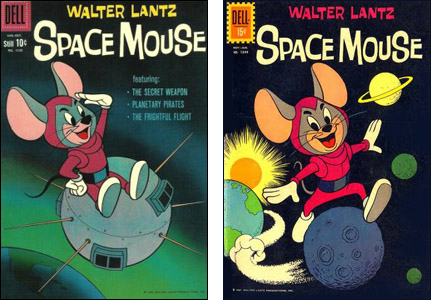![]()

How did the Walter Lantz character Space Mouse appear in a Dell comic book years before he appeared in a Walter Lantz cartoon?
Space Mouse, which was a fairly successful comic book for a very brief time, was owned by Mr. Lantz but, oddly enough, neither he nor his studio had anything to do with its creation. To explain how it came to be, we have to go back to when Western Publishing Company held the license to produce comics based on whatever Mr. Lantz owned. This led to a roster of comics like Woody Woodpecker, Chilly Willy and Andy Panda. At this point, Dell Publishing paid Western to prepare the contents of their comics — often using characters licensed to Western by others — and then to print them. Dell financed the comics, controlled the distribution and decided what to publish. (If you don't understand the odd relationship between Western and Dell, this page explains it in greater detail. But basically, you need to know that Western held the license to do Lantz comic books and they sold their wares to Dell.)
One day in 1958 or 1959, Western Publishing's execs realized that they were paying a lot of money to Walter Lantz for the rights to his characters but that they weren't getting as many different titles out of the arrangement as they would have liked. So they told Chase Craig, who was their senior editor, to see if he could launch another comic based on a Lantz property. Chase looked over what Lantz owned and decided none of the other characters could sustain his own comic. Then his eyes fell on a press release from Walter Lantz Productions that said they were producing a cartoon called "Space Mouse." Chase instantly imagined a Buck Rogers kind of situation with a mouse in a space suit and thought, "Hey, that would make a great comic." So he called Lantz's office and had them send over a copy of the storyboard for the cartoon.
Well, it turned out the cartoon was not what Chase had been expecting. It was the first cartoon in an intended series starring characters named Hickory, Dickory and Doc and most of it took place on Earth, with dogs and cats and mice chasing each other around. Still, Chase needed a new Lantz comic and he thought the Buck Rogers mouse was a great idea and the title of the Lantz cartoon was the perfect name…
So he got together with one of his writers and an artist and they created the comic he had in mind. They did up a few pages, then Chase took it over to Walter Lantz's office and said, "Is it okay if we do this?" And Lantz, who was going to wind up with the copyright, of course said it was fine with him. When the first issue of the comic sold well, he added the character to his catalog of properties that were available for merchandising. Then in 1963, he produced a Space Mouse pilot cartoon entitled "The Secret Weapon," directed by Alex Lovy and featuring Johnny Coons as the voice of the astro-rat. It aired on his TV program, The Woody Woodpecker Show, but failed to graduate to a regular series. (It's included on a DVD, Woody Woodpecker and Friends, Volume 1, which is currently available by mail from Columbia House.)
The comic book didn't last long but it's kind of interesting that just as "Walt Disney's Uncle Scrooge" was created for the comic books and wound up a full-fledged Disney property, Space Mouse also went from licensee to licensor instead of the other way around.
And that's the story…except that it might get someone to wondering why, if Chase thought he had such a good, original idea, he gave the idea away to Walter Lantz, rather than do it as a comic that would be owned by his own company, Western Publishing. This is where Dell comes into the story.
As I mentioned, at the time, Western created and printed the comics and Dell, a separate company, published them. At just that moment, there was a small battle going on between the two companies over the ownership of properties in non-licensed comics. Throughout the years Western and Dell had their business arrangement, almost all their comics were licensed material…characters owned by Disney or Warner Brothers or Lantz or some other outside firm. There were a few new characters (Turok, Son of Stone, for instance) but each time, Dell said, "Hey, we're financing these books. We oughta own the property" and Western said, "No, it was created by our employees. We're going to own it or we won't do it."
As a result of these squabbles, there were periods when Western decided to not create any new characters…and Space Mouse was birthed during one of those periods. When I asked Chase why he just turned the concept over to Lantz, he said, "I didn't want to find myself in the middle of a fight over who'd own it if Lantz didn't. Relationships were already strained with Dell." Just a few years later, Dell and Gold Key parted ways…but at least it wasn't because they were quarreling over Space Mouse.
(Thanks to Jerry Beck and Dave Mackey for supplying info on the Space Mouse TV cartoon.)